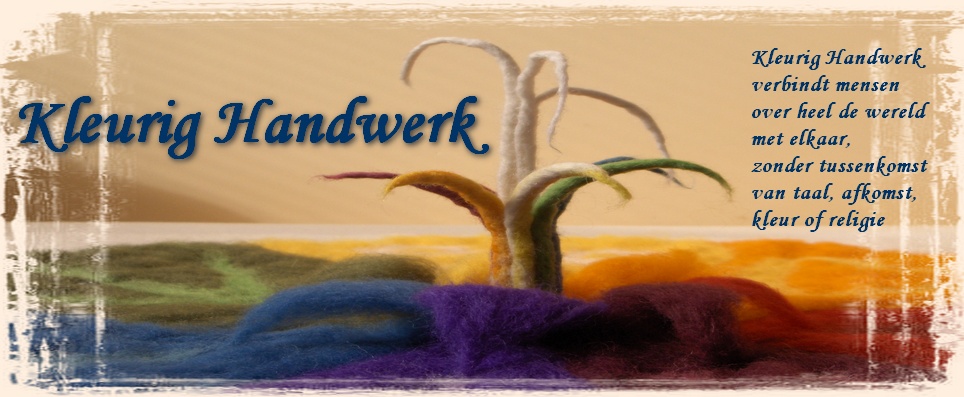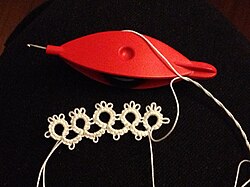Wie denkt dat de handwerkvorm 'Frivolité ' ouderwets is en dat het niet meer beoefend wordt, heeft het mis.
Het is een handwerkvorm die tegenwoordig meer nog in andere landen beoefend wordt, maar er bestaat ook in Nederland een Frivolité kring.
Via het blog van Corina genaamd De Handwerktuin kwam ik erachter dat deze mooie vorm van kantknopen nog volop gedaan wordt.
 |
| foto van blog van Corina |
Wat is nu precies Frivolité?
Frivolité is een handwerktechniek, waarbij op kant lijkend weefsel wordt vervaardigd.
De techniek is al minstens enkele eeuwen oud. In het Centraal Museum in Utrecht is een Chinees frivolité-spoeltje van bewerkt been te zien, dat afkomstig is uit de tweede helft van de negentiende eeuw, maar ook in de tijd daarvoor werd frivolité gemaakt.
Het verschil met kant is, dat er niet gevlochten of geweven wordt, maar geknoopt. Anders dan bij kant wordt bij frivolité niet met veel draden tegelijk, maar met één of hoogstens twee gewerkt.
De techniek is niet lastig. Afwisselend wordt met het zelfde spoeltje een rechter- en een linkerknoop gemaakt. Belangrijk is dat de knopen zo aangetrokken worden, dat ze schuifbaar blijven. Zo kan, nadat een aantal knopen is gemaakt, alles worden dicht getrokken tot een rondje, dat de basis is van het eindresultaat. Meestal worden regelmatig stukjes garen open gelaten, die na het dichttrekken van het rondje een open lusje vormen aan de buitenkant daarvan.
In het engels heet het Tatting
Tatting is a technique for handcrafting a particularly durable lace from a series of knots and loops. Tatting can be used to make lace edging as well as doilies, collars, accessories such as earrings and necklaces, and other decorative pieces. The lace is formed by a pattern of rings and chains formed from a series of cow hitch or half-hitch knots, called double stitches, over a core thread. Gaps can be left between the stitches to form picots, which are used for practical construction as well as decorative effect.Tatting dates to the early 19th century. The term for tatting in most European languages is derived from French frivolité, which refers to the purely decorative nature of the textiles produced by this technique. The technique was developed to imitate point lace
In German, tatting is usually known by the Italian-derived word Occhi or as Schiffchenarbeit, which means "work of the little boat," referring to the boat-shaped shuttle; in Italian, tatting is called chiacchierino, which means "chatty.

Shuttle tatting
Vintage tatting shuttles from the early twentieth century.Newer type of shuttle with hook.
Tatting with a shuttle is the earliest method of creating tatted lace. A tatting shuttle facilitates tatting by holding a length of wound thread and guiding it through loops to make the requisite knots. Historically, it was a metal or ivory pointed-oval shape less than 3 inches (76 mm) long, but shuttles come in a variety of shapes and materials. Shuttles often have a point or hook on one end to aid in the construction of the lace. Antique shuttles and unique shuttles have become sought after by collectors — even those who do not tat.
To make the lace, the tatter wraps the thread around one hand and manipulates the shuttle with the other hand. No tools other than the thread, the hands and the shuttle are used, though a crochet hook may be necessary if the shuttle does not have a point or hook.
Needle tatting
Needle tatting in progress. A completed closed ring of 5ds segments with a picot loop between each is shown. Another uncompleted loop is still on the needle.Tatting pin
Traditional shuttle tatting may be simulated using a tatting needle or doll needle instead of a shuttle. There are two basic techniques for needle tatting. With the more widely disseminated technique, a double thread passes through the stitches[citation needed]. The result is similar to shuttle tatting but is slightly thicker and looser[citation needed]. The second technique approximates shuttle tatting because a single thread passes through the stitches.
Needle tatting originated in the early twentieth century, but did not become popular until much later[citation needed]. A tatting needle is a long, blunt needle that does not change thickness at the eye of the needle. The needle used must match the thickness of the thread chosen for the project. Rather than winding the shuttle, the needle is threaded with a length of thread. To work with a second color, a second needle is used. Although needle tatting looks similar to shuttle tatting, it differs in structure and is slightly thicker and looser because both the needle and the thread must pass through the stitches. However, it may be seen that the Victorian tatting pin would function as a tatting needle. As well, Florence Hartley refers in The Ladies' Hand Book of Fancy and Ornamental Work (1859) to the use of the tatting needle, so it must have originated prior to the mid-1800s.
In the late 20th century, tatting needles became commercially available in a variety of sizes, from fingering yarn down to size 80 tatting thread. Few patterns are written specifically for needle tatting; some shuttle tatting patterns may be used without modification. There are currently two manufacturers of tatting needles[citation needed].

Cro-tatting
Cro-tatting combines needle tatting with crochet. The cro-tatting tool is a tatting needle with a crochet hook at the end. One can also cro-tat with a bullion crochet hook or a very straight crochet hook.In the 19th century, "crochet tatting" patterns were published which simply called for a crochet hook. One of the earliest patterns is for a crocheted afghan with tatted rings forming a raised design.
Patterns are available in English and are equally divided between yarn and thread. In its most basic form, the rings are tatted with a length of plain thread between them, as in single-shuttle tatting. In modern patterns, beginning in the early 20th century, the rings are tatted and the arches or chains are crocheted.
Many people consider cro-tatting more difficult than crochet or needle tatting. Some tatting instructors recommend using a tatting needle and a crochet hook to work cro-tatting patterns.
Stitches of cro-tatting (and needle tatting before a ring is closed) unravel easily, unlike tatting made with a shuttle.
A form of tatting called Takashima Tatting, invented by Toshiko Takashima, exists in Japan. Takashima Tatting uses a custom needle with a hook on one end.
It is not that widespread however (in Japan the primary form of tatting is shuttle tatting, and needle tatting is virtually unknown.).
Materials
Older designs, especially through the early 1900s, tend to use fine white or ivory thread (50 to 100 widths to the inch) and intricate designs. Often they were constructed of small pieces 10 cm or less in diameter, which were then tied to each other to form a larger piece — a shawl, veil or umbrella, for example. This thread was either made of silk or a silk blend, to allow for improper stitches to be easily removed.[citation needed] The mercerization process strengthened cotton threads and spread their use in tatting.Newer designs from the 1920s and onward often use thicker thread in one or more colors, as well as newer joining methods, to reduce the number of thread ends to be hidden.
The best thread for tatting is a "hard" thread that does not untwist readily. Cordonnet thread is a common tatting thread; Perl cotton is an example of a beautiful cord that is nonetheless a bit loose for tatting purposes. Some tatting designs incorporate ribbons and beads.
(tekst en foto's komen van Wikipedia)
* In dit filmpje op YouTube laten ze zien hoe het werkt.
Er worden prachtige dingen gemaakt met Frivolité.
Zelf heb ik vroeger de basis geleerd, voor de modevakschool, en ik heb het spoeltje en garen nog steeds in mijn handwerkdoos, dus wie weet ga ik het ooit nog weer wel eens proberen............




Geen opmerkingen:
Een reactie posten
Dankjewel, dat je op mijn blog komt kijken.
Ik vind het ook heel leuk als je een berichtje achterlaat.
Groetjes van Marianne